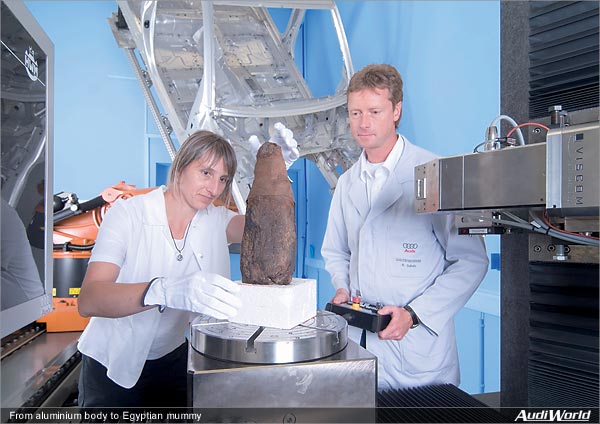Investigations at Audi Using Computer Tomographs: From Aluminium Body to Egyptian Mummy

Never before has any system been able to investigate vehicle bodies at Audi with such precision: with an accuracy in the micron range, in other words about one hundredth the width of a hair, a uniquely configured computer tomograph (CT) at Audi in Neckarsulm is capable of screening not only individual components, but this is what makes it so special entire vehicle bodies. The advantage of being able to examine objects without any contact and non-destructively meant that the CT system at Audi has also been used for an examination of a very special “patient”: a mummified ibis, around 2,000 years old, from Abydos in Egypt, which was provided by the Hesse State Museum in Darmstadt. Dr. Erwin Keefer, from the Wurttemberg State Museum, is thrilled with the first pictures of this rare object from antiquity: “This is the first time in Germany that a mummified object has been screened using an industrial CT system the uniquely high-resolution pictures are a great help to us in our research”. Keefer regards the CT system at Audi as the most innovative method of investigating mummified objects. Until now, it has only been possible to obtain two-dimensional X-ray pictures; by contrast, the pictures taken by the CT system are 50 times sharper. They can consequently assist with the compiling of three-dimensional images that can be used to examine the mummified bird’s feather stalks for mites or fleas. The pictures of the ibis provide the team of researchers with detailed information about the general state of preservation of this sacred bird of Ancient Egypt. Keefer and his team are consequently able to draw conclusions about the skin and its surface, the contents of the stomach, and its sinews, organs and cervical vertibrae information that is accurate down to cell level, but had remained inaccessible when the two-dimensional X-ray images were its only source. The taxidermist of the Hesse State Museum in Darmstadt, Michaela Kurbel, likewise believes there are major advantages to computer tomography: “We can unwrap the mummy entirely without physically destroying its exterior ultimately leaving the mummy intact.” 3D animation will even help the sacred ibis to fly. Ibises from Ancient Egypt are among the most commonly mummified animals. The birds were kept in aviaries in great numbers. The sole purpose of this practice was so that they could be embalmed as votive offerings after their death, because they were the embodiment of the god Thot. But back to the main purpose of the CT system at Audi in Neckarsulm: costing around one million euros and weighing ten tonnes, the system is normally used for closely scrutinising joining techniques involving aluminium and lightweight construction methods. X-rays are fired slice by slice through weld seams, punched joins, laser-welded seams and clinched joins. “An important new departure is that parts can now be examined without any contact and non-destructively,” explains Dr. Manfred Sindel, from Aluminium Technology Quality Assurance at Audi. It was previously necessary to cut components out of the body in order to examine them for any inaccuracies. There is a wide range of possible applications for the CT, from minute electronic components with diameters of three millimetres to body components over five metres long. Whereas patients lie down for examinations by computer tomography, objects for industrial applications are positioned initially upright on a turntable. To enable even large components such as entire vehicle bodies to be examined, Audi’s system has been customised for the automotive industry. The large components are secured to a robot that brings them into the desired position. While the object is rotated in the X-ray, the computer tomograph compiles X-ray projection images for between 100 and 1,000 different angles. To this end, the object to be screened is positioned between an X-ray source which emits the rays and an X-ray detector which converts the X-rays into electrical signals and compiles what is known as a shadowgraph. The 3D reconstruction thus obtained of the object being investigated permits a great many different angles of view. The observer can for example cut a virtual section through the object with the aid of the computer, or “fly through” it in order to obtain an impression of its physical properties from any perspective. The computer tomograph itself is located in a 45 square metre radiation-proof booth operated by specially trained staff. The personnel’s additional qualifications cover primarily the operation and maintenance of the plant, evaluation of the measurements with suitable software and X-ray protective measures. The aim of project manager Dr. Michael Brodmann and his team was in particular to shorten the work processes with the aid of the system; this includes the investigation proper and the evaluation of the results. The production technology of the Audi A8 body is now routinely monitored with the aid of the CT system. Several complete bodies are investigated in entirety each year. This involves measuring every detail of thousands of joins and evaluating them non-destructively. “The system is in addition used for projects for defining quality standards and for sampling new parts,” adds Brodmann. Even the investigation of a rather different “patient”, the mummified ibis, is beneficial according to Brodmann: “This gives us the opportunity to test the system on entirely different materials and broaden our experience both in how to use the system and in how to process the data”. Perhaps one day it will even be used on a real Pharaoh.
|
